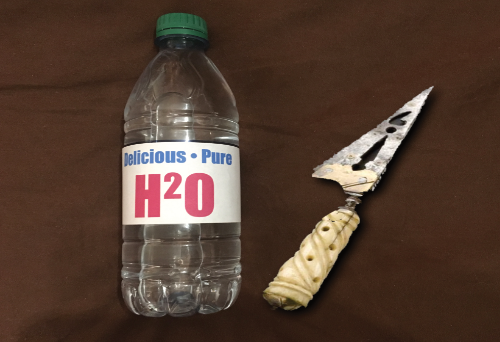
Another common claim the evangelical community makes in rejecting the requirement of obedience for salvation is the assertion that baptism is like circumcision, it is a work of human effort.
Three Passages to Evaluate
Let’s carefully examine three passages of scripture commonly used to demonstrate that circumcision and baptism are related and both are works. The general argument may be summed up like this: “Old Testament circumcision is a foreshadowing of New Testament baptism. It is a symbol of one’s obedience to God’s commands but it is only a symbol. Abraham was declared righteous before he was circumcised and so are we the instant we put our faith in Christ. Baptism, like circumcision is simply a sign and symbol of our salvation.”
Here’s the first support passage. It is in Galatians. In it, we learn that circumcision has no value for the Christian because it is a work and that faith is the only thing which is important.
Galatians 5:6
For in Christ Jesus neither circumcision nor uncircumcision has any value. The only thing that counts is faith expressing itself through love.
Let’s put everything in context. In Galatians, we are talking about physical circumcisions as practiced under the Old Covenant. Jews were required to obey that command and it was performed on infant males the eighth day after birth. When we erroneously compare baptism to circumcision, we get a glimpse of how the church might have begun the practice of infant baptism. When one equates Old Testament requirements with New Testament requirements some strange things can happen.
Paul tells us circumcision is of no value, it is worthless. There is only thing which is important: “faith expressing itself through love.”
Making Connections
While Paul compares circumcision to this new way of faith and love, there is no reason to conclude that he is connecting the two things or linking them in any fashion. One is Old Testament and one is New Testament. Obviously, this scripture is not about baptism at all but it may be helpful to reason out how evangelicals make the connection to baptism when they use this scripture as a proof text.
The impetus comes at the end of the passage: “The only thing that matters is faith…” We have seen this before. This is the “faith alone” argument. This scripture says the only thing that matters is faith, so we assume everything else is worthless… which includes baptism. I suppose this scripture is a pretty good proof text to use if you are convinced that salvation is by faith alone and obedience to Christ’s commands is worthless.
Unintended Consequences
Using this scripture introduces a problem for an evangelical. It indicates that faith actually contains some kind of action… “faith expresses itself.” How does faith “expresses itself?” In love. How does action relate to love? Remember from John 14:15-17 and 2 John 6, we do not love Christ if we do not obey his commands. Obedience is an action.
Let me remind you what those scriptures say;
John 14:15-17
“If you love me, you will obey what I command. And I will ask the Father, and he will give you another Counselor to be with you forever–the Spirit of truth.” And then…
2 John 6
“And this is love: that we walk in obedience to his commands.”
Submitting to Christ’s command to be baptized is one way we express our faith in love. True faith always contains action. True faith is always obedient.
Circumcision of the Heart
Here’s the second proof text used to argue that baptism is like circumcision. In this passage, some think Paul actually equates circumcision with baptism.
Colossians 2:11-14
“In him you were also circumcised, in the putting off of the sinful nature, not with a circumcision done by the hands of men but with the circumcision done by Christ, having been buried with him in baptism and raised with him through your faith in the power of God, who raised him from the dead.
When you were dead in your sins and in the uncircumcision of your sinful nature, God made you alive with Christ. He forgave us all our sins, having canceled the written code, with its regulations, that was against us and that stood opposed to us; he took it away, nailing it to the cross.”
Paul is not equating Old Testament circumcision with New Testament baptism, he is using Old Testament circumcision as a metaphor and calls New Testament baptism a “circumcision of the heart.” One circumcision was under the Old Covenant and the circumcision of the heart is only done under the New Covenant.
This New Covenant circumcision is done by Christ and is effective for three things. It puts off the sinful nature, makes us alive with Christ and forgives all our sins! Old Covenant circumcision did none of that. It should be clear that Paul’s metaphor compares two completely different things. One is effective under the New Covenant, one is ineffective and gone. New Testament baptism has nothing to to with Jewish circumcision.
Putting Off the Sinful Nature
More importantly, if we just put this in the proper context, this passage is actually telling us that baptism is necessary as part of the salvation experience. Let’s walk through this.
Paul begins by telling these Colossian Christians… people who are already saved… at some point in the past they “put off the sinful nature.” This means, at some time in the past, their sins were removed. This happened when they were circumcised by Christ, not physically but spiritually. This is not something these people did to themselves or had done to them by a rabbi. Christ circumcised them. When in the past and where in the past did Christ do this? Paul points to their baptism. What if they refused to allow Christ to circumcise their heart? Would their sins have been forgiven? I don’t think so.
Now, this gets even more interesting. Consider the fact that there is only one spiritual circumcision done by Christ. It happens once and never again. This happened for the Colossians in something called baptism. Was this water baptism or spiritual baptism?
In Ephesians 4:4 the Bible makes an important statement which has a huge impact on our debate. It tells us, “there is only one baptism.” Is that a spiritual baptism or a water baptism?
Get ready for a light bulb to come on.
Two Baptisms
We know from scripture there appear to be two baptisms associated with this “Born Again” experience. We see a spiritual baptism, which we will talk about in a moment, and we see a physical baptism in water, like the baptism of the Ethiopian Eunuch. If we don’t understand New Testament baptism correctly, it may be because we’ve been missing the fact that there are two parts of the same event, the “what” and the “who.”
When we see a person being baptized in water, what is happening? Physically, there are being immersed in water and raised up again out of that water… easy to see. Now, who is baptizing them? No! Not the pastor! The Holy Spirit! That’s what the scriptures teach us. “We are baptized by one Spirit into one body;” 1 Corinthians 12:13. It is not a man who does the spiritual baptizing, it is the Holy Spirit baptizing you at the time of your obedience in water baptism. This is a mysterious, amazing, awesome and wonderful process God has ordained.
When we understand that physical baptism and water baptism are two facets of the same event we can understand how to harmonize Ephesians 4:4 with the fact that we see multiple baptisms mentioned in the New Testament. I have a podcast about the issue of multiple baptisms coming up shortly because it is another one of the arguments in the Evangelical arsenal.
Let’s dig a bit deeper and read the second part of this Colossians 2:10 proof text.
When does all of this happen? When are we dead in our sins; before and during baptism. When does God make us alive with Christ? When we are “raised with Christ” in baptism. It says, “He forgave us all our sins.” How is this done, through our good works? No, through our “faith in the power of God.” This again, is faith in action.
Listen carefully.
We can not be raised by our faith if we were not buried with Christ in baptism.
Paul goes on to assure us, this is not a human work, this is an act of God. Man has nothing to do with this nor is there any power in the water. It is clear from everything in this passage that before the Colossians were baptized, they still had their sins intact. At the point in time of their obedience in baptism, those sins were removed “by Christ,” through their faith in Christ and God’s power… not their faith in baptism or their faith in their good works.
Circumcision of the heart is not water baptism. It is what happens in water baptism. It’s what Jesus does to us during water baptism. We can’t possibly have anything to do with this… the whole thing happens to us when we are dead and buried.
Honestly, there is probably no better scripture is illustrate how our faith and our actions work together just like James teaches us.
Salvation Before Circumcision?
Our third scriptural proof text used to demonstrate that baptism is like circumcision is from Romans. In Romans 4:10, we learn that righteousness is credited before, not after circumcision. Two arguments are offered using this scripture. The first argument: “Abram was righteous before he obeyed God and so are we.” The second argument: “Circumcision is a sign, after the fact, and so is baptism.” Let’s join Paul’s lesson, already in progress. The context… Paul is talking about that time God gave Abram a credit of righteousness.
Romans 4:10-11
“Under what circumstances was it credited? Was it after he was circumcised, or before? It was not after, but before! And he received the sign of circumcision, a seal of the righteousness that he had by faith while he was still uncircumcised.”
Using this passage, once again, evangelicals attempt to equate baptism to the ritual of circumcision. This scripture is not about baptism. It is about God crediting righteousness to Abram before he was circumcised. The evangelical claim is: “God saved Abram before he obeyed circumcision. Since baptism is like circumcision, God saves you before you are baptized!”
There are two problems with this claim. First, circumcision is not like baptism, other than serving as a metaphor, as we have already discussed. Second, God did not save Abram before he was circumcised. God gave Abram a “credit” of righteousness. This is not yet a declaration of righteousness. Please listen to my podcast or read my article here at A Faith that Obeys titled, “A Credit of Righteousness.” It is amazing how we can assume things about statements the Bible makes but when we dig a little bit we discover there is so much more to the story and we have only seen the surface. God’s “Credit of Righteousness” is one of those things that makes deep rich bible study so much fun.
So, trying to use Romans 4:10 to demonstrate that baptism is something that happens after we have righteousness falls a bit short of the goal. Credit is not ownership.
OK, so that wraps up this particular objection “baptism is like circumcision.” I do hope you are enjoying the podcast and I hope you will take a minute to join the mailing list so you will be up to date on all the happenings here at A Faith that Obeys. You are always welcome to chime in with your comments on the blog. It would be great to have you.
Enjoy!Dana Haynes

